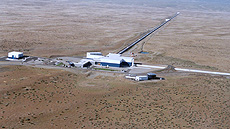Gravitational waves and where to find them
 |
Advanced LIGO has just begun its search for gravitational waves. |
For thousands of years, astronomy was the province of visible light, that narrow band of colors the human eye can see.
In the 20th century, astronomers pushed into other kinds of light, from radio waves to infrared light to gamma rays. Researchers built neutrino detectors and cosmic ray observatories to study the universe using particles instead. Most recently, another branch of lightless astronomy has been making strides: gravitational wave astronomy.
It's easy to make gravitational waves: Just flap your arms. Earth's orbit produces more powerful gravitational waves, but even these are too small to have a measurable effect. This is a good thing: Gravitational waves carry energy, and losing too much energy would cause Earth to spiral into the sun.
Gravitational waves are an important prediction of Einstein's general theory of relativity. According to that theory, a variety of astronomical objects—such as supernova explosions, pairs of black holes and other mutually orbiting objects with strong gravity—give off energy as disturbances in the structure of space-time that propagate outward at the speed of light.
Even though these waves are ubiquitous and often carry enormous amounts of energy, gravity is so weak that they barely nudge other objects as they pass.
But sufficiently sensitive detectors could measure these waves.
Read more
|